Our dear friends, Lois and Dick Powell, contacted us in September saying they had decided to spend New Years in the south of Spain and did we want to join them. It didn't take us much time to say “Yes” and when we mentioned the excursion to Jon’s brother Howie and Pat they decided to join us. So January 28th we embarked on an American Airlines jet at LAX and on the morning of the 29th, after changing planes in Madrid, we stepped off an Iberia flight from Madrid to Malaga on the Costa del Sol.
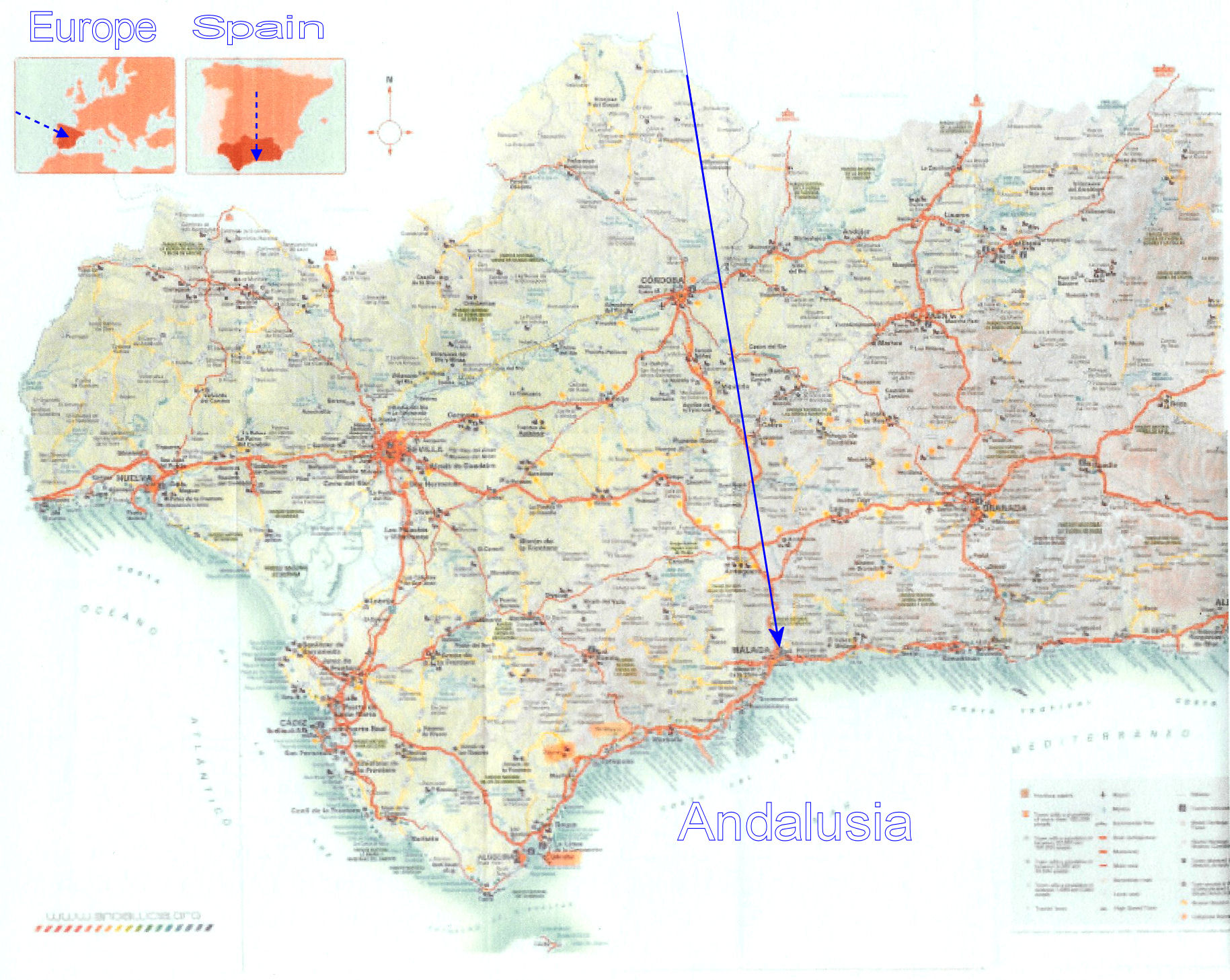
Taking a taxi south along the coast we arrived in Marbella at the Marriott Beach Front Vacation Club where we met Lois and Dick (Howie and Pat were staying in a Timeshare condo about 10 minutes away). We all met for dinner at our resort and planned our doings for the next several days.
We had made arrangements for three trips, to Tangiers, Gibraltar and Rhonda. When we arrived we were notified that the trip to Tangiers (scheduled for the next morning) was cancelled. This prompted a series of phone calls to the USA (Expedia) in an attempt to reschedule; Howie must have spent a good hour on his cell phone before it could be straightened out… we cancelled the Gibraltar trip and rescheduled Tangiers for that day.
The next morning we decided to rent a car and drive to Gibraltar. The concierge at the Marriott arranged for a car to be delivered to the hotel and Lois, Dick, and Linda climbed in, Jon was driving, and we caravanned with Howie and Pat in their car, southwest along the Mediterranean coast to the Spanish city directly adjacent to Gibraltar.
Since Gibraltar is United Kingdom territory we had to pass through customs as we walked from Linea de la Concepción (Spain) into ‘The Rock.” We hired a local guide and his van and spent about two hours as he drove us to the major sights of Gibraltar. We rode through the narrow streets of the city and then up into the nature preserve that
covers the majority of the upper area, along narrow lanes with two-way traffic and hairpin curves.
Passing by the Moorish Castle (built in 1160 , although the tower we could easily see dates to 1333) we drove to a lookout called The Pillars of Hercules - right out of ancient Greek mythology. We could see the Atlantic Ocean and the Mediterranean Sea and Africa across the water of the ‘straight.’ It was easy to see what a strategic piece of real estate “The Rock” is for controlling shipping moving between the two bodies of water.
Then to St. Michael’s Cave. The ‘rock’ is mostly limestone and is honeycombed with caves. We walked through this one and enjoyed the shapes and colors created by the stalagmites and stalactites. In one large cavern an amphitheater had been created.
As we emerged it was raining and we were treated to the first of our numerous encounters with the Barbary Apes that inhabit the area. We were warned not to open our waist pack or purse when one of the
apes were nearby because they would reach in and take whatever they could grab.
They could touch us but we couldn't touch them- they're protected, and nasty. They were everywhere.
Next we drove to The Siege Tunnels first created during the Napoleonic wars in 1791. They were carved by hand into the rock with gun embrasures looking out over the level areas below.
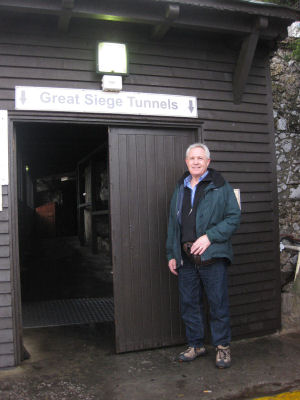
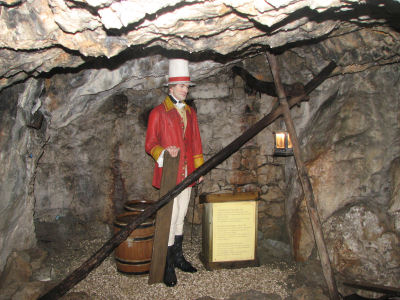
Then back down into the City of Gibraltar where we ate lunch and poked around before walking through the marina and across the airport runway to get to customs and the car.
Howie and Pat headed north and we started back towards Marbella. We decided to visit one of the ‘White Towns’ and turned north into the
 mountains to Casares. Driving the twisting mountain roads we climbed several thousand feet up from the coast. We stopped at one point to stretch and found a memorial to local victims of the Spanish Civil war, complete with statue and tended graves.
mountains to Casares. Driving the twisting mountain roads we climbed several thousand feet up from the coast. We stopped at one point to stretch and found a memorial to local victims of the Spanish Civil war, complete with statue and tended graves.
The town was charming, built almost entirely on streets cut into the mountainside.
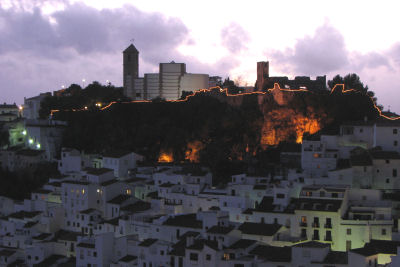
We stopped for hot tea and ran into Howie and Pat who had come into the town from the other side. As darkness (and more rain) fell we headed back towards the coast. Howie and Pat headed to their condo and we made the decision to look for a restaurant along the way.
In San Pedro Alcántara we found a delightful Italian Restaurant, enjoyed a wonderful meal and met a most delightful host (by seeking a restaurant open at 7:45 pm we were the first customers that evening – Spaniards do not normally eat until 9 pm).
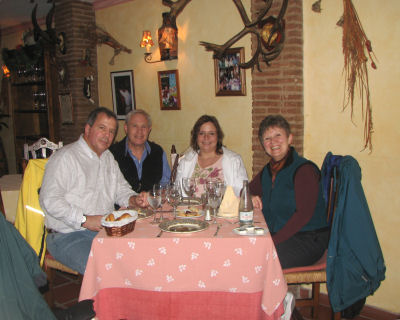
Thursday morning found us and the Powell’s waiting by the front gate of the resort for the excursion coach. It arrived with Howie and Pat already on board and off we went to Ronda, an ancient mountain town.
The town is built on both sides of the El Tajo gorge and has several bridges connecting the two sides. The town has evidence of prehistoric settlements from as early as 25,000 BC. The geography makes the town a natural fortress so it’s not surprising that it was the Romans who established the fist major settlement. After the Moors' conquest in 711 AD, Rhonda became one of the most important towns of southern Spain. It was conquered in 1485 by Ferdinand and Isabella of Spain and brought into the newly established Kingdom of Spain.
The coach let us off (in the rain) at the outskirts of town and we followed our guide through narrow streets with medieval buildings to the church Santa Maria la Mayor which dates from the 13th and rebuilt in the 15th century.From there we crossed the Puente Nuevo (new bridge) that connects the two parts of the town. It was built in
1751 and stands 321 feet above the river below. Peering over the side we could see the remaining Roman bridge standing further up the gorge.
(click to see a video of the bullring)
Crossing the bridge we arrived at the Plaza de Toros and its bullring. The bullring was inaugurated in 1785 and is one of the widest rings in the world. We walked through the back preparation areas and then into the ring itself. After a mediocre lunch we wandered in the town for a brief time before heading to the coach and the ride back to Marbella. We joined Howie and Pat for dinner and then went back to their condo to celebrate New Years Eve - we even had the twelve grapes as the clock struck midnight and watched fireworks from the balcony.
The next morning Dick, Lois and we decided to rent a car again and drive to the ‘White Town’ of Mijas. It’s a ‘tourist’ town because it is close to the Mediterranean coast and we thought we’d just spend an hour or so there. Not so. We found the town and its medieval walls charming and spent most of the day wandering and sightseeing. From the very tourist ‘donkey taxi’ to the numerous shops and vistas looking south into the sea we spent the day wandering. After lunch in a delightful out-of-the-way family-owned restaurant we continued walking about the charming town.

The town has the only square bullring (outside shape) in Spain and we found a woman and her husband making buñielos (fried dough sprinkled with powdered sugar) on the street outside the bullring.
___
We were taking a short rest when Howie and Pat drove up and we directed them to the sights we had discovered.
The next morning found us waiting for the coach at 6:30 am to take us to Tangiers in Morocco. The coach took the group along the coast highway to Tarifa, a port just north of Gibraltar where the ferry crosses to Africa.
After a 45 minute ride across the Mediterranean Sea on the high-speed boat we disembarked at Tangiers, picked up a local guide and loaded into a tour bus. He narrated what we passed through as we drove through downtown, modern Tangiers and across to the Atlantic shore.
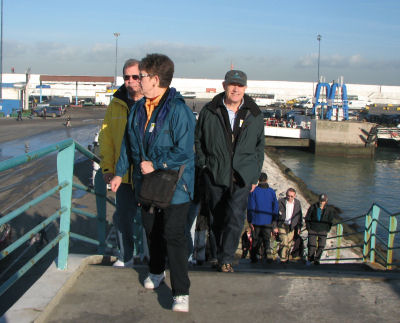
Our first ‘tourist’ stop. A man with several camels where we could get rides as well as looking at the ocean.
Back into the bus and a ride back to Tangiers’ old quarter, the ‘casbah.
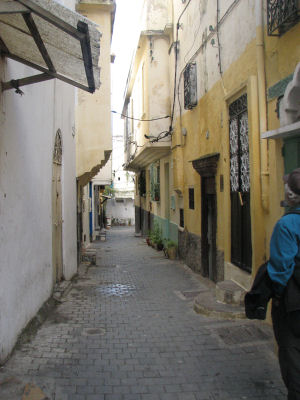
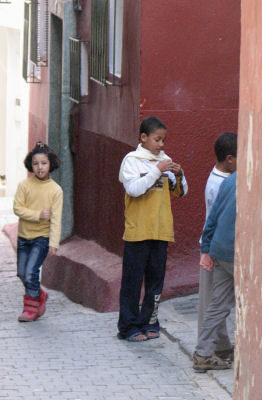
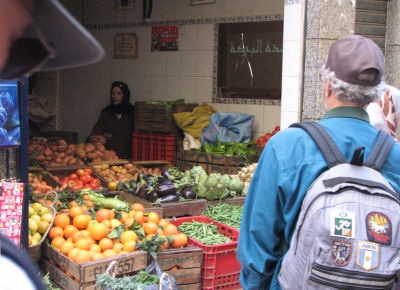 As soon as we disembarked the coach we were subjected to a swarm of street vendors. It was as if they were assigned to us for they remained with us and waited while we ate lunch. Our guide led us through narrow streets lined with small shops selling all sorts of wares,
As soon as we disembarked the coach we were subjected to a swarm of street vendors. It was as if they were assigned to us for they remained with us and waited while we ate lunch. Our guide led us through narrow streets lined with small shops selling all sorts of wares, food stuffs and tourist goods. We could not stop because the street vendors would immediately close in, it was not comfortable. The guide described various things we were looking at as we walked. We passed a snake charmer, and followed our guide into a large shop where we were given a very brief talk about Moroccan rugs and encouraged to buy.
food stuffs and tourist goods. We could not stop because the street vendors would immediately close in, it was not comfortable. The guide described various things we were looking at as we walked. We passed a snake charmer, and followed our guide into a large shop where we were given a very brief talk about Moroccan rugs and encouraged to buy.
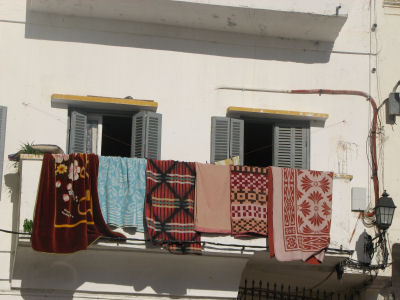
Then out into the street (where the vendors were waiting for us) and to a tourist restaurant where we
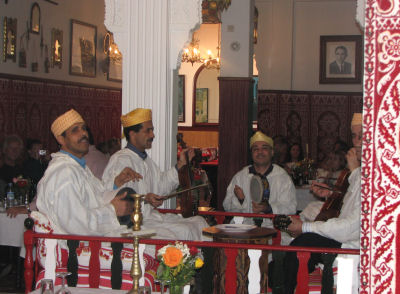 listened to Moroccan music and a woman danced while the meal was eaten.
listened to Moroccan music and a woman danced while the meal was eaten.
After the meal we were taken to a shop where we were given a talk on Moroccan herbs, and encouraged to buy. We continued walking until we came out to the edge of the casbah overlooking the Mediterranean where the coach was waiting to take us back to the ferry.
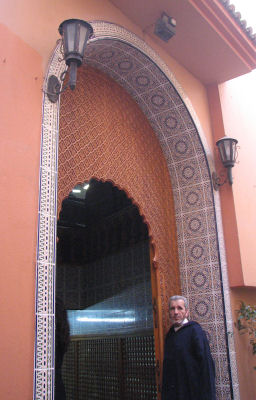
Over all a rather disappointing day - we were never allowed to wander Tangiers alone, subjected to extremely ‘touristy’ shops and besieged by street vendors all selling the same stuff. On the ride back to Spain on the ferry most people on the tour fell sleep.
The next morning Lois and Dick departed for home and Jon and Howie drove to Malaga to exchange the car that Howie and Pat were using for a larger auto that would accommodate the four of us. We all packed ourselves and the luggage and drove towards Granada through rain showers. The countryside quickly became hilly and the hillsides covered with olive trees as far as we could see.
Granada is a large city with towering, snow covered mountains rising behind it. We entered Granada in the mid-afternoon and drove directly to the Alhambra.
The Alhambra is one of Spain’s jewels. Construction began in the 14th century but it is a collection of buildings built over time. The Casa Real (Royal Palace) presents delicate arches with intricate carving and fountains. The water elements, the mosaics, the floors, the ceilings- all combine to create a sense of wonder. It sits on the top of a hill and consists of three parts: the Royal Palace, the Alcazaba (fortress) and the Medina (today, the gardens).
A fourth part of the complex, the Generalife (Summer Palace) also stands on the hill.
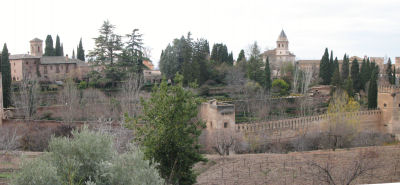
We strolled the garden pathways during the late afternoon dodging the occasional rain shower and looking out over the city of Granada. We wandered the halls of the Royal Palace marveling at the intricacies of the artwork on walls and ceilings, and the beauty of the gardens and water decorations.
We found a hotel in a small town just outside of Granada and made arrangements to attend a Flamenco presentation that evening. A bus came to pick us up and as it wove its way through the streets of downtown Granada we got to see the city and the many people out shopping. The bus worked its way through narrow streets to the base of the hill that has the Alhambra on top and we got to see the edifice lit up at night.
The dance and dinner was in a ‘cave,’ rooms carved out of the soft rock of the hill- very traditional. We enjoyed a nice meal and the dancing and took a short walk to reach a vantage point for looking at the illuminated Alhambra
.
Click to see a video of the Flamenco dancing)
The next morning Linda did not feel well so we visited a nearby Clinic while Howie and Pat roamed the area. The ‘doctor’ diagnosed that her dizziness and nausea was caused by the compression of the neck because of tightened muscles and prescribed some medication. After picking it up at a nearby pharmacy we met Howie and Pat and decided to continue driving up the road into the nearby mountains. When we reached a point where it was snowing and snow tires/chains were required we had to turn around and take the motorway towards Córdoba.
Our trip to Córdoba was in the rain. We passed flooded fields and rushing rivers Sand the usual hillsides covered with olive trees. We stopped for lunch in a small town but found nothing open (siesta time) except one 'tourist' restaurant.
We did have a good meal but an even better laugh at the English translation of the Spanish menu.
Córdoba is one of the oldest cities in Spain. It was the capital of a Roman province (206 BC), a cultural capital of Moorish Spain (929 AD) and eventually became part of the re-emerging Catholic empire (1236). It is the home of La Mezquita, a magnificent and unique mosque.
We reached the city in the early evening and found a hotel on the outskirts. It looked beautiful, what we could see 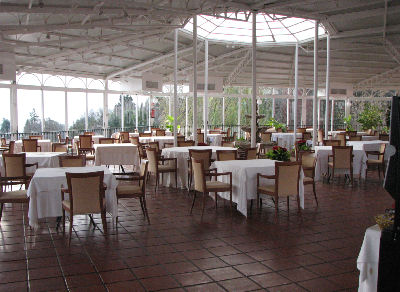 through the rain, but
through the rain, but the rooms were small and Howie and Pat were subjected to an invasion of ants during the night.
The next morning, however, came with sunlight and we drove into the center of Córdoba and left the car in an underground parking lot. We walked into the medieval Jewish Quarter through one of the city’s ancient gates (the Puerta de Almodóvar).
The Jewish community dates from the time of the Roman emperors and its synagogue (built in 1315) is one of only three medieval synagogues remaining in Spain.
The Jewish community under the Romans and the Moors thrived and was the home of Maimonides, one of the greatest philosophers of Jewish history. We walked the ancient narrow streets through the ‘craft quarter' and arrived by the very large, rectangular outer wall (with a bell tower in the middle of one outer wall) of the Mezquita. It is the oldest building in day-to-day use in the Western world with construction begun in 786 AD. Inside there are hundreds of columns of different colors, made from different materials. They support arches that stretch to the ceiling. in the middle of the building is a Gothic church that was placed there by a Catholic monarch in 1523, and small chapels are arranged along the outer walls.
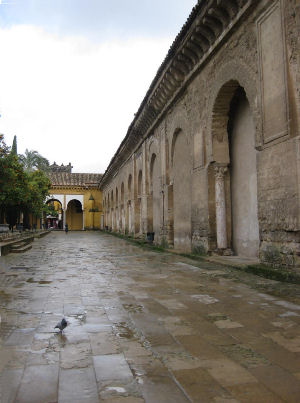
What a magnificent edifice. We walked in through the original mosque of Abd-al- Rahman I and then into an extension built by Abd-al-Rahman II. Walking through the maze of pillars you pass a section of a Roman floor that has been left open, seen by looking down through the layers of the different floors that have been added since Roman times.
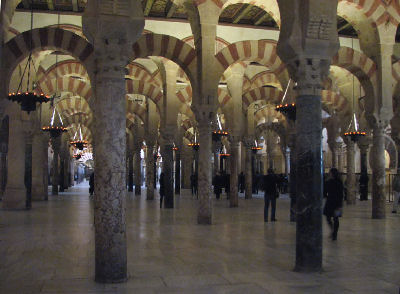
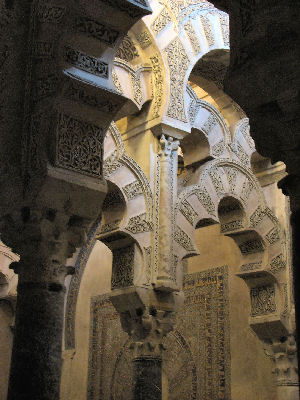
In the center is the medieval cathedral, still in use with chapels ranged along the outer walls of the mosque. We passed into a magnificent section built by al-Hakam that extends to towards the bank of the River Guadalquivir. The cathedral introduced into the building human images (which are everywhere), taboo in Islamic art and architecture.
We left the mosque/cathedral into a rainstorm and stopped for a traditional Spanish lunch. Afterward we walked to the river and the Roman bridge that spans it. The Guadalquivir was at flood stage so we could not walk to the normal riverbank and admire the Roman construction.
At this point Linda was feeling quite poorly, the dizziness and nausea had returned full tilt. The local Tourist Office (situated by the Mezquita) suggested that we go to the Reina Sofia University Hospital so we took a cab there while Howie and Pat went wandering the old city, agreeing to meet at 6 pm at the car. The hospital emergency room was busy but, as we walked in the door, an attendant took Linda’s name, and then directed us to a triage nurse took her information. She directed us to a door saying that Linda’s name would be called. We were seated no more than six or seven minutes when the door opened and a nurse called her. We went in and Linda was given a thorough examination by a doctor, who prescribed three injections (for dizziness, nausea, and to relax Linda’s neck muscles). She wrote out a prescription and sent us to the hospital pharmacy who gave us enough medicines to last until we got back to the USA. She then refused any payment saying that the national health system was there to serve everyone in Spain! And we, here in this country, can’t do that?
We took a taxi from the hospital and, as we were traversing the streets, saw that several were being closed by the police. The driver explained that all over Spain there was going to be parades and celebrations that evening and if we didn’t get out of town right away we would be stuck until the next day! Luckily Howie and Pat arrived on time, we got into the car and drove out of the underground parking only to find that the street was full of people and the police had restricted traffic. We inched the car along trying to move through the crowds until a bystander took pity on us and had the people move so we could pull onto the parade route. So we cruised slowly up the avenue – and people waved at us! A policeman directed us to an escape route and we were able to leave town and head towards Seville.
We drove in a rainstorm past drowned fields and the miles and miles of olive trees, arriving in Seville in the early evening. Our plan was to head into the town center and find one of the many hotels but the roads were closed for parades! We drove about tying to find a way in but finally settled on a hotel located alongside the motorway.
The next morning we drove into the city center and parked by the Guadalquivir River near the bullring.
We walked along the riverfront avenue (Paseo del Christobal Colon) looking at the architecture (buildings and the Customs House, the ‘Castillo del Oro’ where the gold from the Americas was landed in the 15th and 16th centuries) and the statues placed alongside the street (figures related to the opera Carmen). Howie and Pat took a boat ride while we wandered into the city. The Guadalquivir River is navigable to Seville from the Atlantic Ocean so it was a medieval port city.
Seville is an old city. It was founded by the Phoenicians in 500 bc and was the fourth largest city in the world in the 1600’s. We walked towards the Cathedral, which is one of the biggest in Europe, enjoying the architecture and stopped for a hot coffee at a Starbucks.
Afterwards we spent a short time inside the cathedral before walking back to the river to meet Howie and Pat.
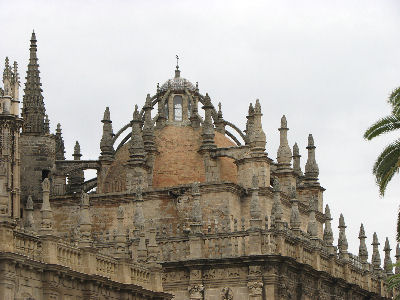
We walked back to the Cathedral only to find that it had closed for the day. So we walked the narrow but picturesque streets back towards the rive, passing a street mime in the guise of a "clay man," and a series of street statues. We stopped to enjoy a cup of chocolate before collecting the car.
We did not spend enough time in Seville and resolved to return for an extended stay.
We decided to make an early start towards Jerez de la Frontera, our next stop. Because we had early reservations at the training center for the Andalucian Dancing Horses we did not want to be rushed finding a hotel. We entered the city in a light drizzle and wandered about until we found an area with hotels.
.
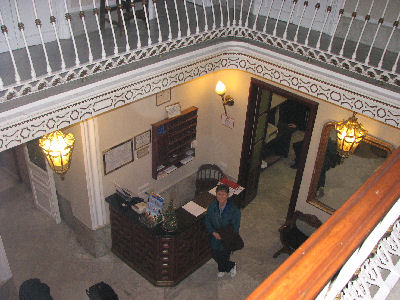
The one we chose was a converted house over 200 years old. It was quaint and old-fashioned. The desk person gave us directions to a non-smoking restaurant and it turned into a very enjoyable and delicious meal. The waiter was a clown and kept us smiling and laughing throughout the meal. He introduced us to a local sherry – Pedro Ximinez – which was truly a joy to savor (we brought a bottle home).
The next morning we made our way, through a rainstorm, to the Fundacion Real Escuela Andaluza del Arte Ecuestre – the School for Andalucian Equestrian Art.
As we entered the grounds the rain stopped and we were able to wander the premises looking at the horses exercising in the paddock.
We then saw a formal show of the horses ‘dancing’ and of carriage driving. Beautiful. We couldn’t photograph the show or the carriages but did get a picture of the tight-turn tracks left in the dirt of the arena’s floor.
(click to see a video of the horses)
Leaving the Equestrian School we walked around the corner to one of the many sherry producers of the Jerez area. Unfortunately, it wasn't open for tourism.
Since we were to leave for home the next morning we decided to get an earlier-than-usual start toward Malaga. We made a decision to follow a route that cut through the mountains and it turned out to be a very beautiful drive. We first came to Arcos de la Frontera, one of the ‘white town’ found in the mountains of southern Spain. Passing through we came to another town spread along the top of a bluff and built down to the river that runs along the escarpment. The river was in flood as we passed by the town and over the river.
We drove further into the mountains through the town of Librique where we stopped for a hot drink and were treated to the “singing” of a local drunk in the tavenra.
From there we climbed into the mountains towards the low-hanging clouds. While we rose in altitude the rain stopped and we were treated to a beautiful vista looking out towards the Atlantic Ocean.
As we continued we found ourselves in a snow storm that turned into hail.
Passing through another mountain town we dropped down on the other side of the range and passed through Ronda, onto the motorway and arrived in Malaga in the early evening.
It was a search to find the Holiday Inn located by the airport because of ongoing construction and the fact (we learned later) that the city would not allow the motel to put up large, permanent signs. We found the hotel full- totally. Flights to Wales and the United Kingdom had been cancelled and the passengers were stranded at the hotel. The Holiday Inn had even run out of food! Luckily we had confirmed our arrival that morning so each of us had a room. We used the car and found a nice Brazilian restaurant and said our goodbyes to Howie and Pat (who were staying one extra day).
Up early and a quick taxi ride to Malaga Airport. A short air trip from Malaga to Madrid, where we were subjected to a full body ‘pat down’ and our hand luggage was completely searched before we could board the plane to the USA. Jon had to twice explain (once to the TSA person and again to a Guardia Civil) and then set up his traveling cribbage board before they would release him to board the plane- they had never seen the game before.
The ancient cities of Andalucia are charming but this was a bit of a rushed trip, too much going from place-to-place quickly. But we do know where we want to come back to and spend more time.